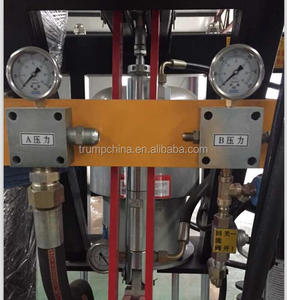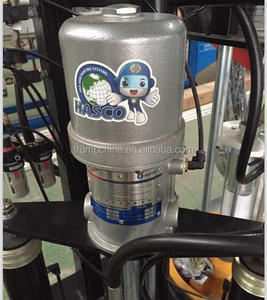
All categories
Featured selections
Trade Assurance
Buyer Central
Help Center
Get the app
Become a supplier

(1219 products available)













































A silicone sealant dispenser comes in various types designed specifically for applying silicone sealants. These types offer distinct advantages in applying sealants to different types of surfaces.
Caulking gun:
An adjustable caulking gun is commonly used to dispense silicone sealant from cartridges. It has a lever-driven plunger that forces the sealant out of the nozzle. Users can control the amount of caulk applied by squeezing the lever with their hands. This manual tool is inexpensive and effective for small projects and repairs. There are different types of caulking guns, such as pressure-type caulking guns, handheld manual caulking guns, and others.
Pneumatic caulking gun:
A pneumatic caulking gun is air-powered and dispenses sealant at a constant pressure. Users need to connect it to an air compressor system. Compared to a manual caulking gun, a pneumatic caulking gun offers more precise control over the flow of sealant. This makes it ideal for applications that require a consistent and even bead of sealant, such as assembly line work or construction projects. A disadvantage is that it is more costly than a manual caulking gun.
Battery-powered caulking gun:
This type of caulking gun is powered by batteries. It dispenses silicone sealant smoothly and consistently without needing a manual or pneumatic trigger. This gun offers the freedom of cordless operation, making it good for outdoor or remote applications. However, the battery life may limit continuous use, and the initial cost is higher than manual options.
Squeeze bottle with a nozzle:
A flexible plastic bottle is another option for a silicone sealant dispenser. The bottle has a nozzle to give a precise application of the sealant. To apply the sealant, users must squeeze the bottle. This method is practical for small or intricate projects and is ideal for getting into tight spaces or corners.
Refillable plastic sealant gun:
This type has a refillable cartridge made of plastic. It allows users to switch out different types of sealants easily. The versatility and customization of this model makes it suitable for various applications.
Silo
Silicone sealant dispensers typically feature a silo for holding material. The capacities of the silos can differ, accommodating various quantities of sealant. For instance, large-capacity silos can hold up to 1000ml or more of silicone sealant.
Discharge mechanism
Silicone sealant dispensers are equipped with discharge mechanisms that control the amount and speed of material discharged. These mechanisms might involve trigger systems, push buttons, or knobs for user-friendly operation and precise control.
The trigger is a common method for controlling the discharge volume by applying different pressures to adjust the discharge speed.
Body
The body of the silicone sealant dispenser is designed to be lightweight and durable, making it easy to maneuver while dispensing silicone sealant. Materials used in construction are typically aluminum alloy, which is more robust and less bulky than plastic but still lightweight.
Regular maintenance and cleaning of silicone sealant dispensers prolong their life and ensure they work properly. Here are some key maintenance tips:
Dispenser Cleaning:
Clean the silicone sealant dispenser's outside and inside surfaces with detergent and warm water. This will assist in preventing residue buildup and keeping the device clean. When cleaning, use soft brushes or cloths to avoid damaging the dispenser.
Avoid Sealant Cure Buildup:
Disconnect and clean the dispensing nozzle after each use to prevent sealant cure buildup, which may clog the nozzle and affect subsequent dispensing.
Periodic Lubric:
Periodically lubricate moving components of the dispenser, such as the trigger and push rod, to keep them moving smoothly. Using silicone-based lubricants or other suitable grease, lubricant for moving parts.
Storage Conditions:
Store the dispenser in dry, cool places out of direct sunlight and away from heat sources. Proper storage protects the dispensers from damage and avoids deformation or deterioration of the material.
Furthermore, regular inspection of the dispenser for signs of damage, wear, or loose components should also be performed. If any issues are detected, timely repair or replacement should be carried out.
Sealant dispensers are primarily used to apply sealants but can be used to apply any adhesive or product that requires consistent and even application. Here are some common applications of silicone dispensers and sealants.
When stocking silicone sealant dispensers for retail, it's essential to offer a diverse range that meets the unique requirements of different customers. Research the most commonly used sealant types and formulations in various settings, including home improvement, commercial construction, and specialized industrial applications. Dispensers designed for gunmetal cartridges are especially popular among DIY enthusiasts and general sealant users. Invest in a variety of dispenser styles, including manual, pneumatic, and electric options, to cater to distinct customer preferences and usage needs. It is also crucial to consider sealant cartridge sizes, as both small and large cartridges are typically used in different applications. Additionally, stock sealant dispensers compatible with different nozzle attachments to cater to customers requiring precise application. Quality and durability are also essential to consider when choosing dispensers to stock for retail. Aim to select dispensers made from high-quality materials to ensure they can handle various sealants without getting damaged. Endeavor to select dispensers that provide easy-to-clean features to ensure maintenance is hassle-free for customers. Effective, thorough, and quality sealant application requires applicators that are comfortable to use. Therefore, when selecting dispensers to stock, choose those with ergonomic designs to provide your customers with a product that will enhance their sealant application experience.
Q1: How can users avoid clogging the nozzle after using a silicone sealant dispenser?
A1: After applying the sealant, plug or cap the nozzle to prevent air exposure and drying. Clean the nozzle immediately after use to avoid product build-up. If temporary, store the dispenser upright in a cool, dry place.
Q2: What are the advantages of using a silicone sealant dispenser gun?
A2: Using a silicone sealant gun can offer many benefits to the user, such as precise application, control and consistency of the sealant, faster and more efficient sealant dispensing, as well as a multipurpose tool that can be used for various types of sealants and cartridges.
Q3: Can users use a silicone sealant dispenser in extreme temperatures?
A3: Yes, but choosing sealants rated for temperature extremes is essential. Also, dispensers work best at room temperature. Heating or cooling the sealant can improve dispensing in extreme conditions.
Q4: What happens if users do not clean the silicone sealant dispenser after use?
A4: If users don't clean it, the residue will harden and clog the nozzle and cartridge, preventing future use. Clogging will require extensive cleaning or disposable refill.
Q5: How do users store their silicone sealant dispensers when not in use?
A5: If users are not using the silicone sealant dispenser, it is best to store it in a dry place and away from extreme heat or cold. Also, if the dispenser has not been used, store it with the nozzle pointing up to prevent leakage.